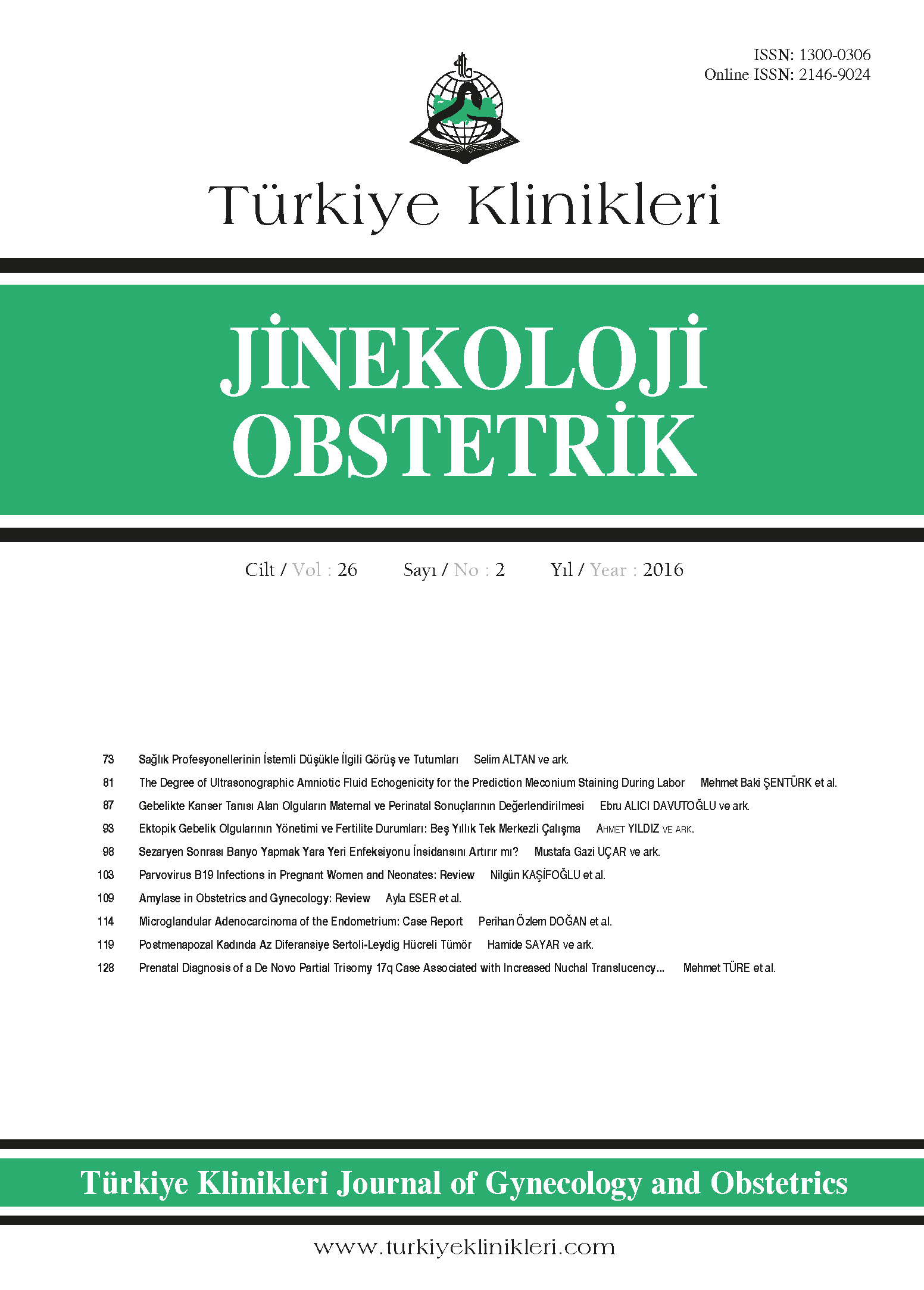Open Access
Peer Reviewed
ORIGINAL RESEARCH
3786 Viewed1913 Downloaded
Management and Fertility Rates of Ectopic Pregnancies: 5 Years Single Center Research
Ektopik Gebelik Olgularının Yönetimi ve Fertilite Durumları: Beş Yıllık Tek Merkezli Çalışma
Turkiye Klinikleri J Gynecol Obst. 2016;26(2):93-7
DOI: 10.5336/gynobstet.2016-50428
Article Language: TR
Article Language: TR
Copyright Ⓒ 2025 by Türkiye Klinikleri. This is an open access article under the CC BY-NC-ND license (http://creativecommons.org/licenses/by-nc-nd/4.0/)
ÖZET
Amaç: Bu çalışmada amacımız, son beş yıllık sürede kliniğimizde ektopik gebelik tanısı alan hastalarda uygulanan tedavi yöntemlerini ve hastaların fertilite durumlarını değerlendirmektir. Gereç ve Yöntemler: Şişli Hamidiye Etfal Eğitim Araştırma Hastanesi Kadın Hastalıkları ve Doğum Kliniğinde 2009-2014 yılları arasında ektopik gebelik tanısı alan hastaların bilgileri retrospektif olarak incelendi. Ektopik gebelik tanısı fizik muayene, serum B-HCG değerleri ve transvajinal ultrasonografi kombinasyonu ile konuldu. hastaların yaşları, beden kitle indeks pariteleri, predispozan faktörler, B-HCG değerleri, gebelik haftaları, başvuru semptomları ile uygulanan tedavi yöntemleri değerlendirildi. Bulgular: Hastaların ortalama yaşı 30,5±5,3 (18-45 yıl),ortalama beden kitle indeksi 23,9±8,2kg/m 2 , ortalama gebelik sayısı 2,2±0,15, tanı konulduğunda gebelik haftası 6,5±1,3 hafta idi. Ektopik gebelik tanısı alan hastaların 351 (%65)'ı medikal,189 (%35)'u cerrahi olarak tedavi edilmiştir. Cerrahi tedavi edilen hastaların 110 (%58,2)'nu laparoskopik, 79 (%41,8)'u laparotomik olarak tedavi edildi. Hem laparotomide hem de laparaskopide salpenjektomi ana prosedür olarak dikkati çekmektedir (%78,3). Laparoskopik prosedürlerde tahmini kan kaybı (mL), transfüzyon ihtiyacı, hastanede kalış süreleri laparotomiye göre istatistiksel olarak anlamlı düzeyde daha düşük izlendi (p<0,05). Gruplar arasında rekürrens ektopik gebelik oranları için istatistiksel olarak fark saptanmadı.İntrauterin gebelik oranları sırasıyla medikal tedavi grubunda %61,4, salpingostomi grubunda %60, salpenjektomi grubunda %38,1 olarak saptanmıştır. Sonuç: Ektopik gebelik tedavi seçenekleri hastanın durumuna göre her hasta için bireyselleştirilmeli ve fertilite koruyucu, konservatif yöntemler mutlaka gözden geçirilmelidir.
Amaç: Bu çalışmada amacımız, son beş yıllık sürede kliniğimizde ektopik gebelik tanısı alan hastalarda uygulanan tedavi yöntemlerini ve hastaların fertilite durumlarını değerlendirmektir. Gereç ve Yöntemler: Şişli Hamidiye Etfal Eğitim Araştırma Hastanesi Kadın Hastalıkları ve Doğum Kliniğinde 2009-2014 yılları arasında ektopik gebelik tanısı alan hastaların bilgileri retrospektif olarak incelendi. Ektopik gebelik tanısı fizik muayene, serum B-HCG değerleri ve transvajinal ultrasonografi kombinasyonu ile konuldu. hastaların yaşları, beden kitle indeks pariteleri, predispozan faktörler, B-HCG değerleri, gebelik haftaları, başvuru semptomları ile uygulanan tedavi yöntemleri değerlendirildi. Bulgular: Hastaların ortalama yaşı 30,5±5,3 (18-45 yıl),ortalama beden kitle indeksi 23,9±8,2kg/m 2 , ortalama gebelik sayısı 2,2±0,15, tanı konulduğunda gebelik haftası 6,5±1,3 hafta idi. Ektopik gebelik tanısı alan hastaların 351 (%65)'ı medikal,189 (%35)'u cerrahi olarak tedavi edilmiştir. Cerrahi tedavi edilen hastaların 110 (%58,2)'nu laparoskopik, 79 (%41,8)'u laparotomik olarak tedavi edildi. Hem laparotomide hem de laparaskopide salpenjektomi ana prosedür olarak dikkati çekmektedir (%78,3). Laparoskopik prosedürlerde tahmini kan kaybı (mL), transfüzyon ihtiyacı, hastanede kalış süreleri laparotomiye göre istatistiksel olarak anlamlı düzeyde daha düşük izlendi (p<0,05). Gruplar arasında rekürrens ektopik gebelik oranları için istatistiksel olarak fark saptanmadı.İntrauterin gebelik oranları sırasıyla medikal tedavi grubunda %61,4, salpingostomi grubunda %60, salpenjektomi grubunda %38,1 olarak saptanmıştır. Sonuç: Ektopik gebelik tedavi seçenekleri hastanın durumuna göre her hasta için bireyselleştirilmeli ve fertilite koruyucu, konservatif yöntemler mutlaka gözden geçirilmelidir.
ABSTRACT
Objective: The objective of this study was to review our management and fertility rates of ectopic pregnancy with the introduction of a gynaecology and obstetrics service at Şişli Etfal Research and Education Hospital between 2009-2014. Material and Methods: A retrospective analysis of 540 cases of ectopic pregnancy managed including operative findings and surgical data were collected over 5 years. The diagnosis of ectopic pregnancy was made by a combination of clinical examination, serum B-HCG assays and transvaginal ultrasonography. Results: Patient's mean age were 30.5 ± 5.3 (18-45 year), mean body mass index 23.9±8.2 kg/m 2 , mean pregnancy parity 2.2±0.15, mean pregnancy week 6.5±1.3. 351 (65%) patient were treated medically, 189 patient (35%) were treated surgically and 58.2% of them were successfully operated laparoscopically. Salpingectomy was the main (78.3%) procedure performed either by laparoscopy or by laparotomy. The estimated blood loss, the need for blood transfusion and the length of hospital stay following laparoscopic treatment were significantly less than those in laparotomy group.There was no statistically significant difference between groups for recurrent ectopic pregnancy rate. Intrauterine pregnancy rates in the medical treatment group were found, respectively 61.4%, salpingostomi group 60%, salpenjectomi group 38.1%. Conclusion: In ectopic pregnancy, treatment options should be personalized as to the condition of each patient and fertility protective conservative methods must be considered.
Objective: The objective of this study was to review our management and fertility rates of ectopic pregnancy with the introduction of a gynaecology and obstetrics service at Şişli Etfal Research and Education Hospital between 2009-2014. Material and Methods: A retrospective analysis of 540 cases of ectopic pregnancy managed including operative findings and surgical data were collected over 5 years. The diagnosis of ectopic pregnancy was made by a combination of clinical examination, serum B-HCG assays and transvaginal ultrasonography. Results: Patient's mean age were 30.5 ± 5.3 (18-45 year), mean body mass index 23.9±8.2 kg/m 2 , mean pregnancy parity 2.2±0.15, mean pregnancy week 6.5±1.3. 351 (65%) patient were treated medically, 189 patient (35%) were treated surgically and 58.2% of them were successfully operated laparoscopically. Salpingectomy was the main (78.3%) procedure performed either by laparoscopy or by laparotomy. The estimated blood loss, the need for blood transfusion and the length of hospital stay following laparoscopic treatment were significantly less than those in laparotomy group.There was no statistically significant difference between groups for recurrent ectopic pregnancy rate. Intrauterine pregnancy rates in the medical treatment group were found, respectively 61.4%, salpingostomi group 60%, salpenjectomi group 38.1%. Conclusion: In ectopic pregnancy, treatment options should be personalized as to the condition of each patient and fertility protective conservative methods must be considered.
MENU
POPULAR ARTICLES
MOST DOWNLOADED ARTICLES





This journal is licensed under a Creative Commons Attribution-NonCommercial-NoDerivatives 4.0 International License.










